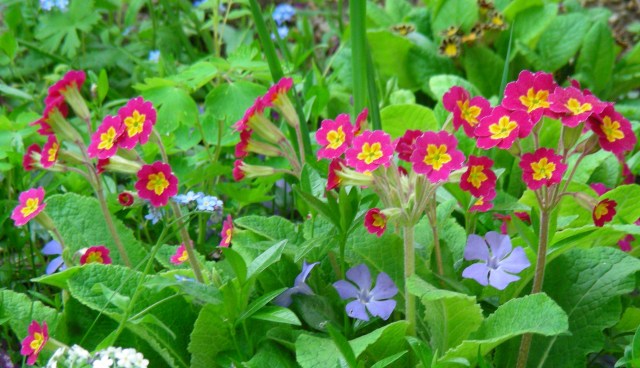This is a photo dump of primulas from late May until the solstice. Click to enlarge.
I built a new primula bed last year and filled it with P halleri, P frondosa, P mistassinica, and P gemmifera, along with a few auriculas. The pink and purple flowered section Aleurtia primulas look similar to one another, and I am not sure these are all correctly identified. Sometimes seed is misidentified, or seed can migrate to the wrong end of the seed tray, or labels get mixed up. (The plants labelled P gemmifera are definitely not, though the seed was said to be. So what are they?) A few of the plants pictured are still in pots, waiting for a place in the garden, mine or someone else’s.
– –
I had a tray of three-year-old P veris seedlings (cowslips) from seed collected from my polyanthus primulas. Because there was P veris in the garden nearby, and P veris is a parent of the polyanthus primulas, the seeds came up as P veris (though not pure P veris). I now have too many cowslips and no longer bother collecting seed from polyanthus primulas. Rather than throw these old seedlings on the compost, I planted them like bedding annuals in clumps of two or three under the rose bushes. Most are yellow, but a few red and orange ones add some excitement. They will be large clumps in a couple of years. Photo below, and then a couple of choice specimens from a previous planting (against the fence, north-facing).
– –
These seedlings were over-wintered indoors because they were very small. Most are Barnhaven polyanthus primroses, but the one in flower is a P elatior. Looks like there is a P mistassinica in there too. The pale, long-stemmed leaves are the last of the indoor leaves. The two darker plants will be Cowichans. All will flower next spring among the Barnhaven primroses already in the garden.
– –
This is my first polyanthus primula, bought at Riverdale Greenhouse more than 15 years ago. It had a name but it’s long lost. It has been much divided over the years and will be again this summer. It beats the showier ‘Pacific Giants’ primroses by virtue of its smaller flowers, held apart and lifted above the foliage (cowslip-like), not clumped together right on top of it.





















Such beautiful colors!!